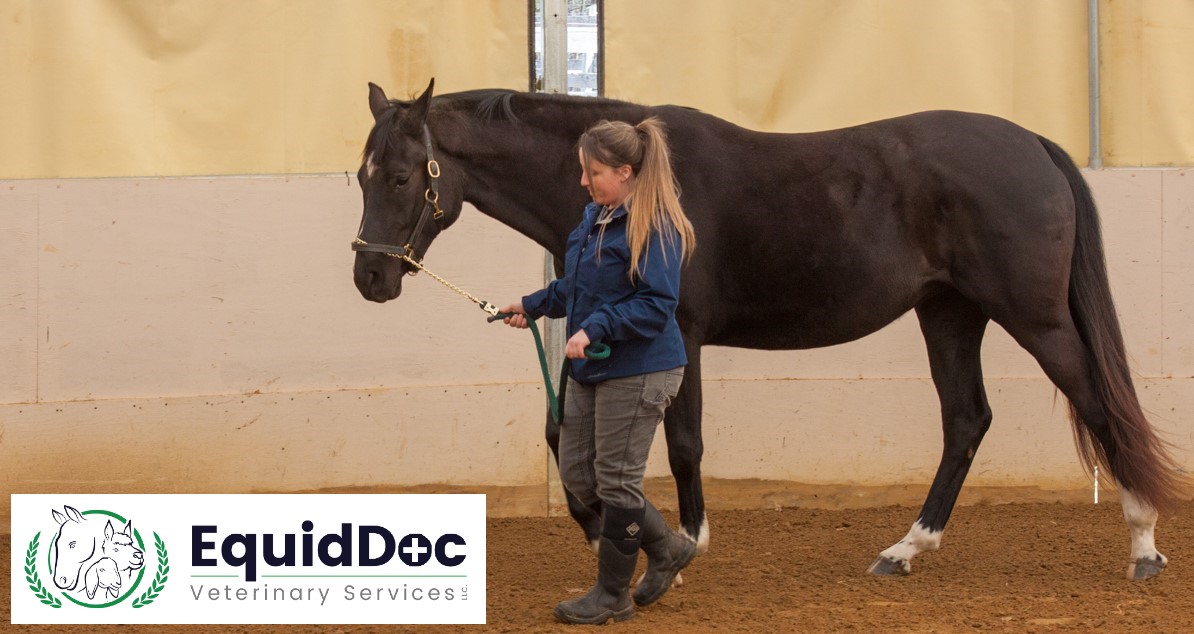If your horse has suffered an injury, you probably expect to hear the words “stall rest” as a part of the treatment plan. Although horses may need to be stalled rather than turned out in their usual pasture, we now prescribe rehabilitation at very early stages of injury healing. The concepts used in equine injury rehabilitation are based upon our understanding of equine biomechanics and borrowed techniques from human physical therapy. Selecting the appropriate schedule and types of rehabilitation is critical for your horse’s successful recovery and return to athletic use. Depending on the type of injury your horse sustained they will initially receive medical treatments, a period of rest, and cold therapy. Often during the prescribed rest, controlled movement and strengthening exercises will be prescribed. All stages of equine injury rehabilitation involve a team of committed owners, caretakers, veterinarians, farriers, and rehabilitation providers.
One of the most important components of rehabilitation (rehab) is a controlled exercise program. Type, duration, and intensity of exercise will all vary depending on the diagnosis of injury and lameness. For some diseases of bones and joints, such as osteoarthritis (OA), low intensity-longer duration exercises are often recommended. Exercises for strengthening certain muscle groups to support an injury may also be recommended. For soft tissue injuries, exercise typically increases in duration and intensity very carefully and gradually. Follow guidelines regarding turn-out closely, often a small-sized turnout or hospital paddock is used to keep your horse from re-injuring himself. Footing for exercise and turn out is also very important depending upon injury type. Sometimes the hard ground is preferred to deep sand, and a flat surface is preferred to hilly or rocky. However, in some cases such as neuromuscular injury, traveling over a variety of surfaces is used to increase stability.
Nutrition, body condition, and nutritional supplementation are also important points of discussion for healing. Some injuries may heal better if your horse is carrying less weight (OA), while others heal better with increased muscle building (patellar ligament laxity). Some nutritional supplements help promote muscle, reduce joint inflammation, and promote bone and hoof health. Consult with your veterinarian for weight loss, nutrition, and supplementation recommendations. Depending upon injury type your veterinarian will also prescribe and make specific shoeing or trimming recommendations. EquidDoc veterinarians are happy to meet your farrier on the farm to best support your horse’s healing process.
Also, Read Equine Sports Medicine Part 2: Beware of the soft tissue tear!
 Healing is a dynamic process and the rehabilitation plan is designed to have periods to check-in and monitor the healing status. For many horses recovering from soft tissue injuries, recheck ultrasound examinations are utilized to monitor the healing progress and adjust treatments and exercises as needed. Recheck soundness/lameness evaluations are also helpful to give confidence that the horse is ready for the next level of rehab. This is important at each step of the exercise program to ensure that an increased workload is appropriate. If lameness reoccurs or ultrasound examination shows negative progress, the rehabilitation plan is adapted.
Healing is a dynamic process and the rehabilitation plan is designed to have periods to check-in and monitor the healing status. For many horses recovering from soft tissue injuries, recheck ultrasound examinations are utilized to monitor the healing progress and adjust treatments and exercises as needed. Recheck soundness/lameness evaluations are also helpful to give confidence that the horse is ready for the next level of rehab. This is important at each step of the exercise program to ensure that an increased workload is appropriate. If lameness reoccurs or ultrasound examination shows negative progress, the rehabilitation plan is adapted.
Additional techniques like massage, chiropractic adjustment, and acupuncture may be utilized to help reduce soreness while building muscle. Breaking the cycle of pain is important to allow proper biomechanical alignment for muscle building and improved healing. Other techniques like medical grade laser therapy, pulsed electromagnetic field therapy, and acupuncture help decrease inflammation and promote circulation to the site of injury. EquidDoc will help you understand which techniques have the research supporting the effectiveness of your horse’s injury. Some therapies have been researched for only specific injuries or injury types while others may have only limited support in certain situations.
A constant dialogue between you and your horse’s caretakers, farriers, and veterinarian is critical for the successful completion of a rehab plan and getting back in the saddle! Schedule your horse’s soundness and performance examination with EquidDoc mobile veterinarians today at 508-885-4205!

